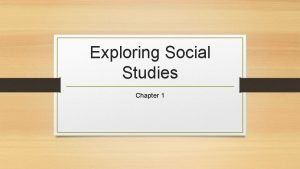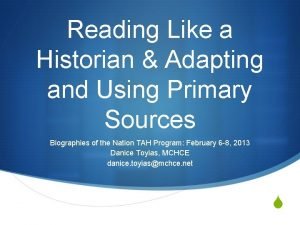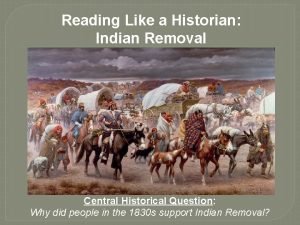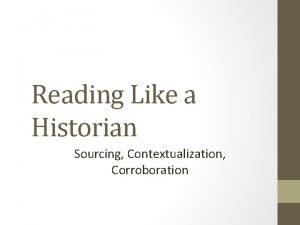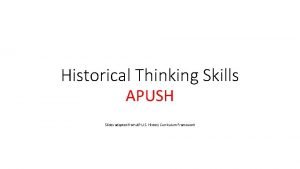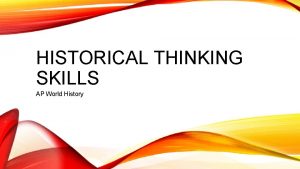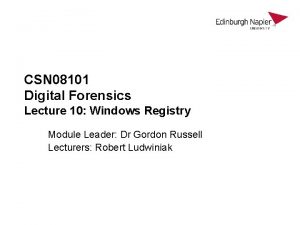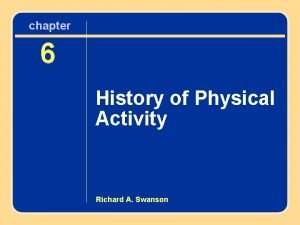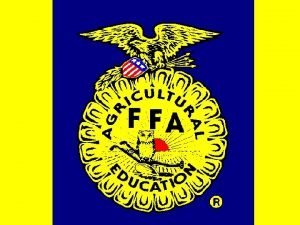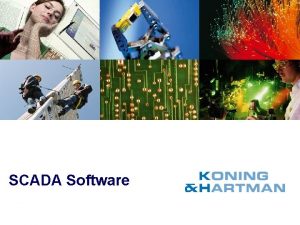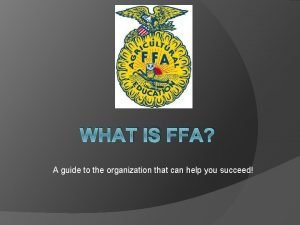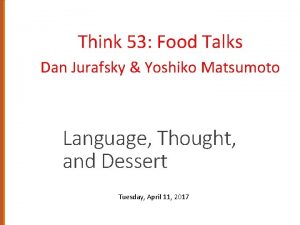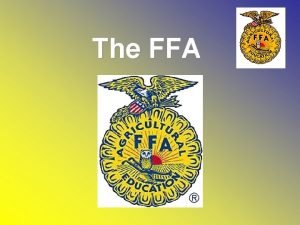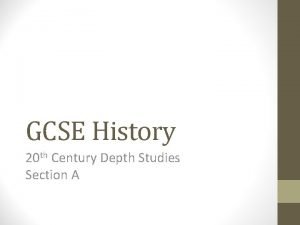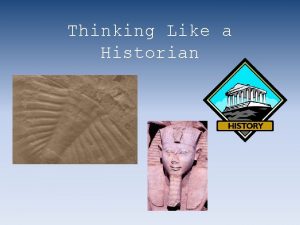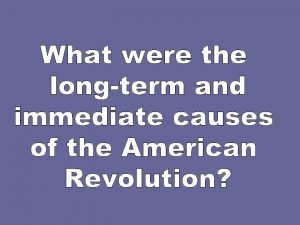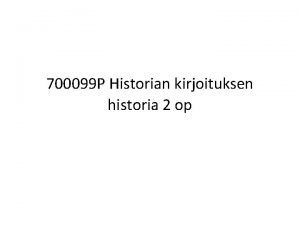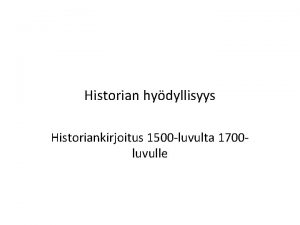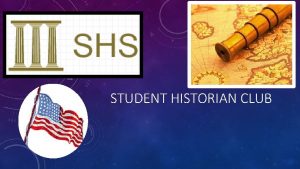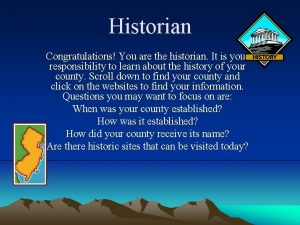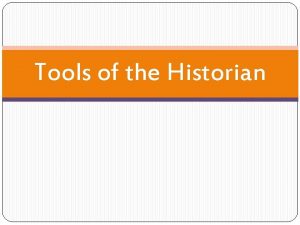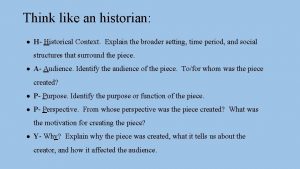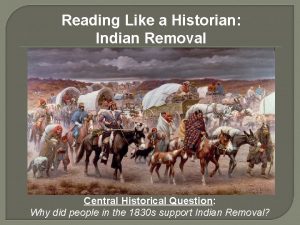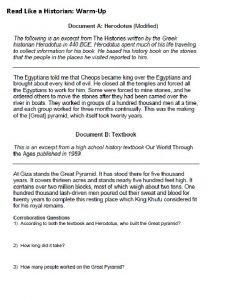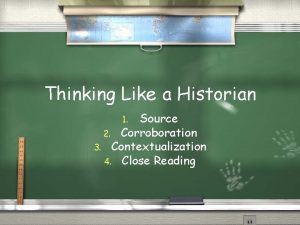Historical Thinking Skills Thinking Like a Historian Thinking

















- Slides: 17

Historical Thinking & Skills Thinking Like a Historian: Thinking, Organizing, Analyzing, and Communicating Information

Objectives --------------------------------------- • Analyze and explore how historical events provide opportunities to examine alternative courses of action (#1). --------------------------------------- • Analyze and explore how the use of primary and secondary sources of information includes an examination of the credibility of each source (#2). --------------------------------------- • Explain how historians develop theses and use evidence to support or refute positions (#3). --------------------------------------- • Explain how historians analyze cause, effect, sequence, and correlation in historical events including multiple causation and long- and short-term causal relations (#4).

To get you thinking… Humans used to believe that the world was flat…that was considered to be a FACT!!!! What could you do to prove that this “FACT” is inaccurate?

I. Why are you learning this? A. We live in a culturally diverse, democratic society in an interdependent world. B. We are bombarded with information due to our modern technology…how do you know which information you can trust? C. By learning to think like a historian, you can be better prepared to analyze and use sources of information. D. You have to be able to make informed decisions based upon credible sources (believable & trustworthy)… NOT your opinion.

II. Types of Sources A. What is a Primary Source? A direct record of the past from an original author (the author was there & experienced it). List some examples you can think of: letters, speeches, interviews, film footage, photographs, political cartoons, journals, essays, autobiographies, emails, My. Space, Facebook, Twitter, Instagram, Tumblr, Instant Messages, text messages B. What is a Secondary Source? An indirect record of the past (the author is restating or interpreting events that others experienced). List some examples you can think of: textbooks, biographies, encyclopedias, most newspaper/magazine articles, any book by an author who did not actually experience the events C. We should always use multiple sources to corroborate (confirm) information.

III. Is a Source Credible? A. What are the qualifications and reputation of the author (background, education, training, & knowledge)? EXAMPLE: Is a Math teacher qualified to write a World History textbook? B. Does the source agree with other credible sources? EXAMPLE: What if the source says “Christopher Columbus discovered the New World in 1493, ” but other sources say it was 1492? C. What is the perspective or bias (preference/favortism) of the author and does it contain propaganda & unstated assumptions? EXAMPLE: Most Media (newspapers, news magazines, radio news programs, and TV news programs) are either Liberal OR Conservative (few are Moderate). EXAMPLE: During WWI, the British exaggerated depictions of German soldiers to make they look evil. EXAMPLE: I hear that our new classmate is Chinese. He must be really smart.

III. Is a Source Credible? D. Does the source contain accurate facts (not opinions) and does it have internal consistency? EXAMPLE: Blue is the best color. EXAMPLE: All apples are red. Therefore, most apples are green. E. What were the circumstances in which the author prepared the source? EXAMPLE: Is an author who is motivated primarily by making a profit on their latest book a credible source? EXAMPLE: Is an author who is writing primarily for a single audience a credible source? EXAMPLE: Can a source written in 1901 be considered a credible U. S. Civil War era primary source? . EXAMPLE: Can a source written in 1981 be considered a credible secondary source for world events occurring today? Propaganda is ALWAYS one-sided and biased… the purpose is to make the other side look BAD!!!

IV. Historical Thinking A. What do Historians do? 1. Develop theses (meaningful interpretations of the past showing historical significance of an event). 2. Use evidence from multiple credible sources to support theses and explain past events. 3. Cite their sources and use their research to support or refute others' theses. B. What can Historical Thinking help you do? 1. Learn how to analyze information. 2. See the relationship between causes and effects. 3. Make sense of the past and connect it to the present. 4. Learn how to communicate by making coherent arguments. 5. Gain a deeper understanding of the world and of people.

IV. Historical Thinking C. Historians Investigate (find out the background/origins of a source before analyzing it): 1. What type of source is is? 2. When was it created? 3. Who created the source? 4. What biases might the author have had? 5. Who was the intended audience for this source? 6. Why might the source have been created? 7. How does knowing the origins of the source influence your understanding of it?

IV. Historical Thinking D. Historians Contextualize (imagine the setting to think about the past on its own terms): 1. What was happening at that time? 2. What was the occasion and location (specifically & generally)? 3. Did people at that time hold different values? 4. What social and political forces were at work at the time? 5. Are you looking at the past through a present-day lens? 6. How does the context shape your understanding?

IV. Historical Thinking E. Historians Corroborate (cross-check to assess the reliability of sources): 1. Do other sources exist? 2. What do other sources say? 3. Can the claims be confirmed? 4. How credible is this source? 5. Are you using multiple sources to back up your claims? 6. How are you addressing competing sources? 7. How are you addressing ambiguities or gaps in information?

IV. Historical Thinking F. Historians Interpret (create an explanation or argument based upon the historical record): 1. What conclusions can you draw? 2. What is your thesis? 3. How do you plan to prove your argument? 4. Are there other possible interpretations? 5. Are you respecting the evidence, yet being original? 6. Are you transforming the documents or merely summarizing them?

IV. Historical Thinking G. Historians Identify and Use Evidence (the sources that form the basis for historical conclusions and judgments): 1. How do you know? 2. What clues do the sources provide? 3. How do you plan to use those clues to make your case? 4. What specifically have you selected to support your claim? 5. What are your strongest and weakest pieces of evidence? 6. How will you organize and integrate your evidence?

IV. Historical Thinking H. Historians Determine Significance (connect the source, topic, or event to the larger context of history and/or current events): 1. How did this event/issue influence peoples' lives? 2. To what extent did this event/issue affect different aspects of society? 3. What was unique about this event/issue? 4. What were some of the immediate and/or long-term effects of this event? 5. Why is this event/issue important?

V. Internet Sources A. Internet Sources need checked just like any other source. B. Types of Internet Domains: 1. . edu = accredited post-secondary institution website 2. . gov = U. S. governmental website 3. . mil = U. S. military website 4. . com = commercial website (anyone can get one) 5. . info = information website (anyone can get one) 6. . net = network website (anyone can get one) 7. . org = organization website (anyone can get one)

Did You Get It? 1. What type of source is a direct record of the past from an original author? 2. What type of source is an indirect record of the past? 3. What do credible sources contain (instead of just having opinions)? 4. What is a source’s preferences/favortism called? 5. What are the meaningful interpretations of the past showing historical significance of an event called?

How can you prove if a “Fact” is accurate?
 Exploring social studies lesson 1 thinking like a historian
Exploring social studies lesson 1 thinking like a historian Why is it important to think and read like a historian?
Why is it important to think and read like a historian? Reading like a historian answer key
Reading like a historian answer key Sourcing contextualization corroboration close reading
Sourcing contextualization corroboration close reading What does historical thinking involve
What does historical thinking involve Ap world historical thinking skills
Ap world historical thinking skills Historical concepts and skills
Historical concepts and skills Mandiant web historian
Mandiant web historian Between 1950 and 2000 physical activity professions
Between 1950 and 2000 physical activity professions Proficy historian
Proficy historian Historians tools
Historians tools Ffa plow symbol
Ffa plow symbol Citect historian
Citect historian Ge proficy historian
Ge proficy historian Ffa treasurer symbol
Ffa treasurer symbol Sapir whorf hypothesis
Sapir whorf hypothesis What is the official salute of the ffa organization?
What is the official salute of the ffa organization? How useful is source a to a historian
How useful is source a to a historian
